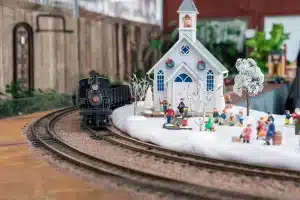The Fascinating History of Model Trains and Railways
Introduction
Model trains and railways have captivated hobbyists and enthusiasts for decades. The miniature world these models create allows individuals to experience the wonder of trains and the railways on a smaller scale. The history of model trains and railways is as fascinating as the hobby itself, filled with innovation, craftsmanship, and a love for trains.
The Origins of Model Trains
The roots of model trains can be traced back to the early 19th century. It all began with the creation of static models, which were constructed by skilled craftsmen who meticulously replicated train engines and carriages. These models were often displayed as intricate sculptures rather than functional toys.
However, it was not until the mid-19th century that model trains became truly interactive. The development of steam power and the rise of rail transportation sparked the imagination of inventors and enthusiasts alike. Model trains then started to move under their power, driven by clockwork mechanisms or even steam engines.
The Rise of Electric Model Trains
The advent of electricity in the late 19th and early 20th centuries revolutionized the world of model trains. Electrically powered model locomotives could now run on tracks with greater precision and control. This breakthrough allowed enthusiasts to build more intricate layouts and create realistic operating railways.
Electric model trains quickly gained popularity, attracting a wide range of hobbyists from children to adults. The ability to control speed, direction, and even sound effects added a new level of realism to the hobby. Model train manufacturers emerged, producing a wide range of train models, track systems, and accessories to cater to the growing demand.
Features and Exciting Aspects of Model Trains
- Scale and Gauge: Model trains come in various scales and gauges, representing different train sizes and proportions. From the tiny Z scale to the larger G scale, each offers a unique experience for enthusiasts.
- Detailed Replicas: Model trains are meticulously crafted with attention to detail. Every component, from the intricate engine parts to the delicate decorations on carriages, replicates the real thing on a miniature scale.
- Realistic Operations: Modern model trains boast impressive features such as sound effects, smoke generators, and realistic lighting. These additions bring the models to life, creating a captivating and immersive experience for the hobbyist.
- Modular Layouts: Enthusiasts can design and build modular layouts, creating miniature worlds with landscapes, buildings, and scenery. This aspect of model trains allows for endless creativity and customization.
- Digital Control Systems: With advancements in technology, digital control systems have become prevalent in the model train world. These systems offer greater control, enabling realistic train operations and even multiple train operation on the same track.
The Enduring Legacy
The fascination with model trains and railways has endured throughout the years. Whether it’s nostalgia for steam-powered locomotives or the love for engineering and craftsmanship, model trains continue to captivate people of all ages.
Furthermore, model trains have also served as educational tools, teaching enthusiasts about the history of railways and fostering an appreciation for the intricacies of how trains operate. Model train clubs and exhibitions provide opportunities for enthusiasts to come together, share their passion, and showcase their impressive creations.
Conclusion
The history of model trains and railways is a testament to the human fascination with trains and the desire to recreate their magic on a smaller scale. From humble static models to technologically advanced systems, model trains continue to evolve, capturing the hearts and imagination of enthusiasts worldwide. Whether you are a seasoned collector or just starting out, the world of model trains offers a captivating and rewarding hobby.





